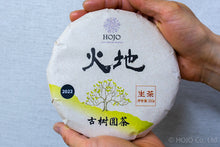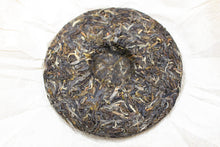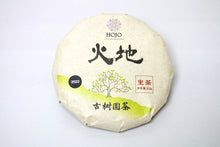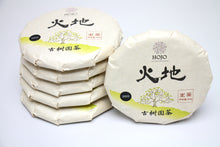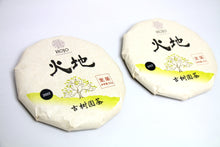
This is a raw pu-erh tea made exclusively from the leaves of a small, single tea garden.
Tea from a Single Garden
"Huo Di" is the name of a tea garden owned by a tea-farming family I’ve had a long-standing relationship with. If you've purchased our limited-edition white teas, you may have come across this garden's name before.
Located in the southwestern part of Lincang at an altitude of around 2,100 meters, Huo Di is an old tea garden where the trees are several hundred years old on average. The garden is maintained without the use of fertilizers or pesticides. Thanks to its high altitude, the age of the trees, and natural, fertilizer-free cultivation, the tea produced here is exceptionally high in quality.
At our shop, we don’t source our teas through local wholesalers or factories. Instead, we purchase loose raw tea leaves (maocha) directly from the tea-farming family who owns and manages the garden—and who are also the primary producers of the pu-erh tea. This direct relationship allows for precise classification by tea garden, enabling us to offer tea that is truly from a single origin.
Huo Di Old Tree Raw Pu-erh: Made from Tender Buds
This tea is typically made from spring harvests in mid-April, using mainly tender bud tips. In the market, old tree teas are highly valued. Normally, farmers will harvest not only the bud tips, but also the side leaves that emerge about a week later, blending both materials to create the final product.
However, the producers we work with own a particularly large tea garden, and each year they simply can’t finish harvesting everything in time. As a result, they often end up picking only the tender bud tips—not by intention, but out of necessity. This leads to a rare and luxurious batch made purely from the finest young buds.
https://hojotea.com/en/posts-264/


A Sustainable, Chemical-Free Tea Garden: Huo Di Old Tree Raw Pu-erh
The Huo Di tea garden is fully managed without the use of fertilizers or pesticides. Throughout the year, the tea trees are largely left to grow on their own, requiring minimal human intervention. Farmers only perform simple maintenance like trimming the grass before the harvest season in spring. The tea trees grow naturally and independently, much like wild plants, and continue to thrive without constant care.
In recent years, such tea gardens have come to be known as sustainable. In other words, the tea trees are well integrated into the local ecosystem and grow in harmony with nature, maintaining excellent health. This vitality can be clearly experienced in the taste of the tea—through its clarity, richness, and lingering finish.
A Bright, Floral Aroma Born from Sunlight
One of the defining features of Huozhi’s tea garden is its excellent sunlight exposure. This ideal environment gives rise to teas with a naturally vibrant and floral aroma. In sun-drenched tea gardens, photosynthesis is highly active, which promotes the biosynthesis and accumulation of monoterpene glycosides such as geraniol and linalool glycosides in the tea leaves.
During the withering stage of processing, these glycosides are enzymatically broken down, releasing volatile aromatic compounds like geraniol and linalool—key contributors to the tea’s bright and expressive fragrance.


Even as a fresh tea, Huozhi’s aroma is already distinct and full of life.
With a few years of natural aging, the dry leaves already give off a notably sweet fragrance. Once brewed, the tea reveals grape-like notes, along with subtle hints of sugarcane and pomelo-like citrus note. Overall, the aroma profile is reminiscent of white wine, with a bright, fruity character that makes it particularly approachable—even for those new to pu-erh.

Raw Pu-erh Tea: Where Quality of the Leaf Matters Most
Raw Pu-erh tea is processed at a lower temperature during pan-frying than green tea, which means more of its natural compounds are preserved without being oxidized. The result is a tea with a remarkably gentle mouthfeel and a flavor profile that highlights the true character of the tea leaf itself. In other words, the quality of the raw material is everything. The higher the quality of the leaf, the longer the lingering finish, the clearer the flavor, and the deeper the overall expression.
High-grade raw Pu-erh is naturally rich in polyphenols and well-suited for aging. As it matures, it gradually develops a soft, fruity sweetness. To encourage this transformation, we recommend aging in an oxygen-free environment to better preserve and enhance these aromatic qualities.
Some may associate Pu-erh with bitterness or astringency—but in most cases, that impression comes from second-pick harvests or teas grown at lower elevations using conventional farming methods. In contrast, first-pick leaves from high-mountain tea gardens offer a smooth, balanced experience, often with a naturally sweet undertone that surprises and delights.
Discover how time, altitude, and natural farming come together in a cup of raw Pu-erh that speaks of purity, patience, and place.
How to Brew Delicious Tea
Choosing the Right Water
For everyday brewing, we recommend using tap water—it's convenient and accessible. However, to remove chlorine (used for disinfection), it's best to boil the water for 3–5 minutes. Keep in mind, though, that boiling alone won't eliminate all the chlorine. For better results, we suggest using a water purifier with an activated carbon filter to reduce chlorine levels more effectively.
Why is this important? Chlorine can react with the aromatic compounds in tea, dulling its natural fragrance. It’s also known to harm not just harmful bacteria, but also the beneficial microbes in our digestive system. In some cases, it may even affect the body at the cellular level and has been linked to allergies.
Avoid using distilled water or reverse osmosis (RO) water for tea, as these contain no minerals and can result in a flat, unbalanced flavor. Mineral-rich water (such as filtered tap water) is ideal for drawing out the tea’s full character.
A note about scale—the mineral buildup often found inside kettles: please don’t remove it. Cleaning with citric acid or descaling agents may alter the taste of your tea. The minerals in scale can actually help enhance the flavor.
Once you've chosen a specific type of water for brewing, try to stick with it consistently. Switching water sources can cause a sudden release of minerals from existing scale buildup, which may unexpectedly alter the taste and make your tea less enjoyable. The key to consistently delicious tea is using the same water every time.






